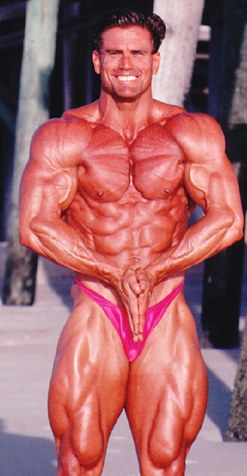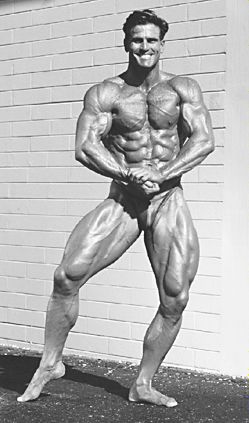
When
you first begin training your contraction levels jump quickly increasing
your strength quickly. After that, gains come slower as fibers thicken
slowly and contraction levels increase and then level off. The development
of new muscle tissue is the only way to increase strength.The only way
to get stronger past a certain point...is to increase your muscle mass
through eating and training.
Muscle strength is generally defined as one's ability to perform a single repetition with maximum resistance. Muscle endurance is usually understood as one's ability to perform many repetitions with a sub-maximum resistance. Muscle endurance may be evaluated at any point beyond the first repetition on the strength endurance continuum.
Although one may train specifically for muscle strength or muscle endurance, there is an inherent relationship between these abilities. Research indicates that most people can perform about 10 repetitions with 75 percent of their maximum resistance. For example, if Kim's maximum bench press is 100 pounds, she will be able to complete 10 repetitions with 75 pounds. If she increases her maximum, single repetition bench press to 120 pounds, she will be able to complete 10 repetitions with 90 pounds. In other words, Kim's 10-repetition resistance changes in direct proportion to her 1-repetition resistance.

Persons
with a high percentage of fast-twitch muscle fibers typically perform
fewer repetitions with 75 percent of their maximum resistance, whereas
persons with a high percentage of slow-twitch (high endurance) muscle
fibers typically perform more repetitions with 75 percent of their maximum
resistance. Because the ratio of fast-twitch to slow-twitch muscle fibers
is apparently unaffected by training protocol, genetics largely determines
our muscle endurance with a given percentage of maximum resistance.
STRENGTH-TRAINING EQUIPMENT
There are basically four categories of strength training equipment. These
include devices that provide isometric resistance, isokinetic resistance,
dynamic constant resistance, and dynamic variable resistance.
Isometric
Equipment
Although isometric (static) equipment is frequently used for testing muscle strength, it is seldom recommended for developing muscle strength because isometric muscle contractions restrict blood flow and may trigger unacceptable increases in blood pressure. Whenever possible, it is best to avoid isometric (static) forms of strength training. However, if isometric exercises are used, you should breathe continuously during each contraction. Advantages of isometric exercise include little equipment, low cost, space efficiency, and time efficiency. Disadvantages include blood pressure escalation, strength increase only at specifically exercised positions in the movement range, training monotony, and lack of performance feedback.
Isokinetic
Equipment
Isokinetic equipment is characterized by a constant movement speed and
a matching resistive force. That is, the amount of muscle force applied
determines the amount of resistive force encountered. More muscle force
produces more resistive force, and vice versa. There are various types
of isokinetic equipment, including hydraulic resistance machines and electronic
resistance machines. Hydraulic machines provide resistance only during
concentric muscle contractions. Some electronic machines provide resistance
only during
concentric muscle contractions, while others offer resistance during both
the concentric and eccentric movements. resistance.
Advantages of isokinetic exercise
include accommodating reinforcement, speed regulation, and detailed performance
feedback. Disadvantages include cost of equipment, forced regulation,
need for training motivation, and lack of accessibility.
Dynamic
Constant Resistance Equipment
Barbells are an
example
of dynamic (isotonic) constant resistance equipment. First,
the amount of resistive force encountered determines the amount of muscle
force applied. More resistive force requires more muscle force, and vice
versa. Second, the resistive force remains constant throughout the exercise
movement. However, due to the mechanics of human movement, the effective
muscle force is higher in some positions and lower in other positions.
As a result, the muscle effort varies throughout the exercise movement.
Advantages of dynamic constant resistance exercise include low cost of equipment, similarity to most work and exercise activities, variety of training movements, tangible evidence of improvement, and easy accessibility. Disadvantages include the inability to train through a full range of joint motion in many exercises, and inconsistent matching of resistive forces and muscular forces throughout the exercise movements.
Dynamic
Variable Resistance Equipment
Dynamic
(isotonic) variable
resistance equipment is similar to dynamic constant resistance equipment
in that the amount of resistive force encountered determines the amount
of muscle force applied. It is different in that the resistive force changes
throughout the exercise movement. By means of moving levers, cams, or
linkage systems, dynamic variable resistance machines provide proportionally
less resistive force in weaker muscle positions and proportionally more
resistive force in stronger muscle positions. Consequently, the muscle
effort remains relatively constant throughout the exercise movement. Dynamic
variable resistance may be provided by specially designed weight- stack
machines and air pressure equipment.
Advantages
of dynamic variable resistance exercise include the ability to train through
a full range of joint motion on most exercises, reasonably consistent
matching of resistive forces and muscular forces throughout the exercise
movements, and (in most cases) tangible evidence of improvement. Disadvantages
include equipment expense, limited number of training movements, and lack
of accessibility.
EXERCISE SEQUENCE
When performing a circuit of strength exercises, it is advisable to proceed from the larger muscle groups of the legs to the smaller muscle groups of the torso, arms, and neck. This permits performance of the most demanding exercises when fatigue levels are lowest.
EXERCISE SPEED
Exercise speed plays a major role with regards to injury risk and strength
development. Fast lifting places high levels of stress on the muscles
and connective tissue at the beginning of each movement. Slow lifting
requires a more even application of muscle force throughout the movement
range. In addition, slow movement speeds are characterized by less momentum
and less internal muscle friction. Although control is the major objective,
a reasonable training recommendation is 1-2 seconds for each lifting movement
(concentric contraction) and 3-4 seconds for each lowering movement (eccentric
contraction).
EXERCISE SETS
An exercise set is usually defined as a number of successive repetitions performed without resting. The number of sets per exercise is largely a matter of personal preference. Several studies have shown similar strength gains from one, two, or three sets of exercise. Clients who prefer single-set exercise usually continue to the point of momentary muscle failure, which is referred to as high-intensity training. Those who choose multiple-set exercise typically rest 1-3 minutes between sets. Multiple-set training may be advisable for those who cannot consistently push themselves hard enough on single-set exercise routines. Regardless of the number of sets performed, each repetition should be done in proper exercise form and under control.
An advantage of multiple-set strength training is the additional calorie use of the longer exercise session. An advantage of single-set strength training is the efficient use of time of the shorter exercise session.
Training progressively
in the key to progress even if you do not train to failure. Training to
total failure can be dangerous and is often too much effort for a person
to correctly recover from. One set done hard and progrssively once
a week is all that is needed to gain strength on any exercsie. There is
no proof that more sets work better, but there is no proof that they don't.
EXERCISE RESISTANCE AND REPETITIONS
There is an inverse relationship between exercise resistance and exercise
repetitions. When exercising to the point of momentary muscle failure,
most people can complete about
6 repetitions with 85 percent of maximum resistance,
8 repetitions
with 80 percent of maximum resistance,
10 repetitions with 75 percent of maximum resistance,
12 repetitions with 70 percent of maximum resistance, and
14 repetitions with 65 percent of maximum resistance.
EXERCISE RANGE
It is important to perform each exercise through a full range of joint movement, with emphasis on the completely contracted position. Full-range exercise movements are advantageous for strengthening the prime-mover muscles and for stretching the antagonist muscles, thereby enhancing both muscle strength and joint flexibility.
EXERCISE PROGRESSION
The key to strength development is progressive resistance. As the muscles adapt to a given exercise resistance, the resistance must be gradually increased to stimulate further strength gains. Of course, the increase in resistance is usually accompanied by a decrease in the number of repetitions that can be performed.
A double progressive program, in which the athlete alternately increases repetitions and resistance, is recommended for safe and systematic muscle strengthening. The athlete begins with a resistance that can be performed at least 8 times. When 12 repetitions can be completed, the resistance is increased by 5 percent or less. For example, when Mary works up to 12 repetitions with 50 pounds, she increases the resistance to 52.5 pounds. When she achieves 12 repetitions with 52.5 pounds, she adds another 2.5 pounds. Under some circumstances it may not be practical to increase the resistance by 5 percent or less.
Although each case must be evaluated individually, it is not advisable to increase the resistance by more than 10 percent between successive training sessions.
EXERCISE FREQUENCY
High-intensity resistance exercise may produce tissue micro-trauma that temporarily reduces strength output and causes varying degrees of muscle soreness. It is therefore desirable to provide ample rest time between successive training sessions. During this recovery period, the muscles synthesize proteins and build to slightly higher levels of strength.
Conventional bodybuilding lore tells us the muscle rebuilding process generally requires about 48 hours, and so strength workouts should be scheduled every other day. The fact is real recovery takes about twice that amount of time. If you plan on getting stronger you have to allow time to recover and then grow from your training. This process can and will, take at least a week in 95% of most athletes. What this means is-- hit each exercise hard-- once a week.
STRENGTH PROGRAM CONSIDERATIONS
The strength training guidelines above address those factors most essential
for a safe and productive exercise session. However, there are additional
considerations that may affect the overall training program.
Common
Training Mistakes
The most common and critical training mistakes have to do with exercise
technique. The tendency to use too much resistance typically results in
poor form, which decreases the training stimulus and increases the risk
of injury. Examples of poor form that are not acceptable are bouncing
the bar off the chest in the bench press, bouncing at the bottom of the
squat, using hip/back extension to initiate barbell curls, bending backward
under barbell presses, using momentum in any exercise, and training at
faster speeds than the exerciser can control.
Warm-Up
It is always prudent to warm up prior to a strength-training workout.
A few minutes of progressive warm-up exercise provide physiological and
psychological preparation for higher levels of effort and energy utilization.
Although warm-up routines may take many forms, it is advisable to include
some aerobic activity such as stationary cycling or stair-climbing. It
is also important to perform static stretching exercises for the major
muscle groups, with particular attention to the low back area.
Cool-Down
Whenever
a vigorous exercise session is stopped abruptly, blood tends to accumulate
in the lower body. With reduced blood return, cardiac output decreases
and light-headedness may occur. Because muscle movement helps squeeze
blood back to the heart, it is important to continue some muscle activity
after the last exercise set is completed. Easy cycling and walking are
appropriate cool-down activities. A few stretching exercises are recommended
at the conclusion of the cool-down. Because of possible cardiovascular
complications, I I never permit clients to omit the cool-down portion
of their workout. As a general guideline the last 10 minutes of the training
session should be dedicated to cool-down activity.
STRENGTH
PLATEAUS
After an initial period of strength gain, most clients experience a strength
plateau during which their strength level remains essentially the
same. Appropriate changes in the training program usually enable the exerciser
to make further progress and attain progressively higher levels of strength.
The following strategies have proved useful in overcoming strength plateaus.
TRAINING FREQUENCY
As we become stronger, we typically perform more demanding workouts. However, more stressful training sessions may require longer recovery periods for tissue-building to be completed. Consequently, itis often helpful to reduce the training frequency. For example, a person who normally rests two days between training sessions may obtain better results by taking three recovery days. A Person who typically trains all of the major muscle groups three days per week may make further improvement by exercising the lower body muscles On Mondays and Thursdays, and upper body muscles on Tuesdays and Fridays.
One of the best routines for getting big muscles is to lift only once or twice a week, focusing on lifting progressively heavier weights, in primary basic movements (like squats, lat pulls, dips, bench). All "light" exercises are dropped (like arm movements, leg extentions and curls, ab work, lateral raises, and so on..) and the focus of training is to solely gain muscles and strength on the big movements. A typical routine would be deadlift, squats, bench, row and maybe calves, done once a week or 3 times every 2 weeks, with emphasis on complete recovery between workouts. Each time you return to the gym you add 1 or 2 pounds to each exercise. You eat like a horse and rest between workouts to maximize growth. Do this routine, for years, till you can deadlift 500 pounds and you will be "strong". When all else fails this routine produces results.
Years of
tests have shown that one intense workout a week with close to maximum
weight for one set with any rep scheme (from 5 to 12 reps generally) will
induce strength gains. Training any more than that has not been proven
to speed up results.
TRAINING EXERCISES
Because our neuromuscular System adapts to specific movement patterns, it is advisable to change the training exercises occasionally. Changing things up, training in cycles, mixing intensity..are the elements that consitute the fine art of Bodybuiding. Genrally speaking, once a routine stops working..switch to a different routine. However, core exercises like squats can be continued for an entire athletic career and included in every cycle of training.
NEGATIVE TRAINING
Because effective muscle force output is greater during eccentric contractions,
negative training is useful for increasing muscle strength. However, lowering
weights that are too heavy to lift creates a higher injury risk for both
the muscles and the connective tissue. It is therefore recommended that
all negative training be carefully controlled and supervised by a conscientious
spotter. As indicated in the previous section, assisted training is an
excellent means for emphasizing eccentric muscle contractions. Another
safe approach to negative training is body weight exercises such as bar
dips and chin ups. For example, Ellen steps to the top position of a bar
dip (elbows extended) and slowly lowers her body to the bottom position
(elbows flexed). This exercise produces controlled eccentric contractions
in the pectoralis major and triceps muscles with little risk of injury,
as the downward movement may be stopped at any time by the spotter.

SLO-MO TRAINING
Another means for making the muscles work harder is to slow the movement speed. Slower movement speeds reduce the role of momentum and require more muscle effort. A general guideline is to take a full 10 seconds for each lifting movement. It will require only a few slow repetitions to produce muscle failure, and the increased muscle tension will be obvious. As with other methods for enhancing the exercise intensity, 10-second training should not be practiced every workout session. It will also be more productive when supervised by an attentive spotter.
FOR MORE ADVANCED TRAINING ADVICE READ MY MASTER BODYBUILDER COURSE
 |
 |
![]()
Machines offer angles and feels only offered by machines. Free weights force a person to use balance and other synergetic factors while lifting a free weight. The answer is, you must train with both. However, free weights alone with a lat machine, a leg curl and a few other classic machines can build a championship physique quite well. A Nautilus Machine (even though I love that stuff ) nor any other machine can do it alone.
